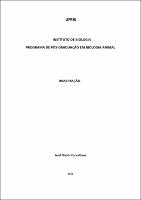| ???jsp.display-item.social.title??? |


|
Please use this identifier to cite or link to this item:
https://tede.ufrrj.br/jspui/handle/jspui/3752| ???metadata.dc.type???: | Dissertação |
| Title: | Variabilidade craniana de três espécies do gênero Thrichomys (Rodentia, Echimyidae), através de técnicas de Morfometria geométrica |
| Other Titles: | Skull variability of three species of the genus Thrichomys (Rodentia, Echimyidae), through techniques of geometric morphometry |
| ???metadata.dc.creator???: | Carvalhaes, Jeiel Gabrir  |
| ???metadata.dc.contributor.advisor1???: | Rocha-Barbosa, Oscar |
| ???metadata.dc.contributor.referee1???: | Pessôa, Leila Maria |
| ???metadata.dc.contributor.referee2???: | Loguercio, Mariana Fiuza de Castro |
| ???metadata.dc.description.resumo???: | O gênero Thrichomys Trouessart, 1880 (Histricognathi: Echimyidae), apresenta uma grande variação de hábitos alimentares, locomotores e comportamentais. Este gênero possui uma sistemática complexa e apesar de já existirem estudos moleculares e morfológicos sobre o gênero, ainda é difícil identificar e classificar estes indivíduos que possuem uma alta diversificação cariotípica. Tais particularidades os tornam interessantes para testar a relação existente entre estas características e principalmente, a forma do crânio. Para tal, o presente trabalho com o objetivo de diferenciar as espécies Thrichomys apereoides, Thrichomys laurentius e Thrichomys pachyurus, utilizou como ferramenta a morfometria geométrica sob marcos anatômicos cranianos. Foram tomadas imagens dorsais, ventrais e laterais de 204 crânios, nas quais foram estabelecidos pontos de referência homólogos. A partir das coordenadas destes pontos, foi possível eliminar o efeito do tamanho das espécies e 1) testar as diferenças entre espécies, entre animais nascidos em biotério e campo e entre sexos assim como suas interações 2) quantificar as diferenças de forma entre as três espécies 3) descrever as diferenças na forma obtidas entre os diferentes grupos testados. Os resultados revelaram diferenças estatisticamente significativas entre a forma do crânio das diferentes espécies assim como entre animais criados em biotério e animais de campo. Também foi detectado dimorfismo sexual na forma. O tamanho não foi significativamente diferente entre nenhum dos fatores analisados. As principais diferenças de forma entre as espécies se localizaram na região parietal e parieto-frontal, nos arcos zygomáticos e na inserção do incisivo. As diferenças de forma entre animais de biotério e de campo se localizaram principalmente na parte posterior do arco zygomático. Os indivíduos de Caetité, BA, são morfologicamente diferentes de outras populações de T. laurentius indicando uma possível dissociação entre evolução morfológica e cariotípica. |
| Abstract: | The genus Thrichomys Trouessart, 1880 (Histricognathi: Echimyidae), shows a wide variation in dietary, locomotor and behavioral habits. This genus has a complex systematic history. Although morphological and molecular studies on the genus are available, it is still difficult to identify and classify these individuals who have a high karyotypic diversification. Such peculiarities make them interesting to test the relationship between these characteristics and skull variation. In order to differentiate the species Thrichomys apereoides, Thrichomys laurentius and Thrichomys pachyurus we used geometric morphometrics on skull landmarks. Pictures were taken dorsal, ventral and lateral sides of 204 skulls, in which homologous reference points were established. From the coordinates of these points, it was possible to eliminate the effect of size of the species and to 1) test the differences among species and between animals born and raised in the lab and field animals as well as between sexes and the interaction between these factors 2) quantify shape differences among species 3) to describe differences obtained among the groups tested. The results revealed statistically significant differences in shape among species, between sexes and between laboratory and field animals. Size was not significantly different between any of the factors analyzed. Major shape differences were located in the parietal and parieto-frontal region, in the zygomatic arches e in the incisive region. Differences in skull shape between laboratory and field animals involve the posterior portion of the zygomatic arches. The individual fo Caetité, BA, are morphologically different from other T. laurentius populations indicating a possible dissociation between morphological and karyotypical evolution. |
| Keywords: | Echimyidae biometria morfometria anatomia estatística Echimyidae biometric morphometrics anatomy statistics |
| ???metadata.dc.subject.cnpq???: | Biologia Geral |
| Language: | por |
| ???metadata.dc.publisher.country???: | Brasil |
| Publisher: | Universidade Federal Rural do Rio de Janeiro |
| ???metadata.dc.publisher.initials???: | UFRRJ |
| ???metadata.dc.publisher.department???: | Instituto de Ciências Biológicas e da Saúde |
| ???metadata.dc.publisher.program???: | Programa de Pós-Graduação em Biologia Animal |
| Citation: | CARVALHAES, Jeiel Gabrir. Variabilidade craniana de três espécies do gênero Thrichomys (Rodentia, Echimyidae), através de técnicas de Morfometria geométrica. 2011. 107 f. Dissertação (Mestrado em Biologia Animal) - Instituto de Ciências Biológicas e da Saúde, Universidade Federal Rural do Rio de Janeiro, Seropédica - RJ, 2011. |
| ???metadata.dc.rights???: | Acesso Aberto |
| URI: | https://tede.ufrrj.br/jspui/handle/jspui/3752 |
| Issue Date: | 29-Jun-2011 |
| Appears in Collections: | Mestrado em Biologia Animal |
Files in This Item:
| File | Description | Size | Format | |
|---|---|---|---|---|
| 2011 - Jeiel Gabrir Carvalhaes.pdf | 2011 - Jeiel Gabrir Carvalhaes | 2.14 MB | Adobe PDF |  Download/Open Preview |
Items in DSpace are protected by copyright, with all rights reserved, unless otherwise indicated.




